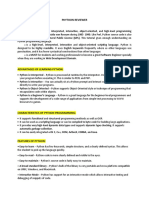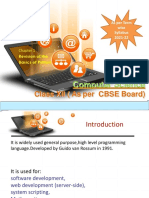Arithmetic Operators in Python
Uploaded by
panagiotisp14Arithmetic Operators in Python
Uploaded by
panagiotisp141.
Arithmetic Operators in Python:
o Python supports various arithmetic operators for mathematical operations:
Addition (+): Adds two numbers.
Subtraction (-): Subtracts one number from another.
Multiplication (*): Multiplies two numbers.
Division (/): Divides one number by another.
2. Input and Output in Python:
o To take input from users, you can use the input() function. It reads a line
from the keyboard and returns it as a string.
Example:
Python
name = input("Enter your name: ")
print("Hello, " + name)
o To display output, use the print() function. You can format the output using
placeholders or f-strings.
Example:
Python
x = 5
print("The value of x is", x)
3. Data Types in Python:
o Python has several built-in data types:
Numeric Types: int, float, complex
Text Type: str
Binary Types: bytes, bytearray, memoryview
None Type: NoneType
o You can check the data type of any object using the type() function.
Example:
Python
x = 20
print(type(x)) # Output: <class 'int'>
4. Scratch vs. Python:
o Scratch:
Block-based programming language suitable for younger students.
Great for creating art, games, and simple projects.
Enriched with hardware integration.
Takes up a lot of screen space for less programm
o Python:
Text-based programming language suitable for secondary students.
More complex but offers unlimited project potential.
Widely used at higher levels of education and in professional
settings.
Takes less screen space for more program which means that you can
make more complex programs
Green = a string
Grey= a comment
Orange = a number or a parameter (or a predefined property
name(for instance .length ))
Purple = special keyword (like var , if , else , etc)
Light-blue = operator ( + , - , * , / , = , < , == , && , etc)
Dark-blue = a predefined function name or the function name
in a function ...
You might also like
- Rick Sekuloski - PYTHON - Master Python OOP Programming With One Guide Only! A Lot of Coding, Practice and Theory Learn Python With Hands-On Projects (2022)No ratings yetRick Sekuloski - PYTHON - Master Python OOP Programming With One Guide Only! A Lot of Coding, Practice and Theory Learn Python With Hands-On Projects (2022)517 pages
- Python - 10 Marks Sol. of Previous PUT_Bharat_AggNo ratings yetPython - 10 Marks Sol. of Previous PUT_Bharat_Agg43 pages
- Pushkar 6 Weeks Industrial Training ReportNo ratings yetPushkar 6 Weeks Industrial Training Report82 pages
- Python Notes Second Semester BVOC Computer ApplicationNo ratings yetPython Notes Second Semester BVOC Computer Application27 pages
- Career Hackers: Hack Your Career Today Python in Finance100% (1)Career Hackers: Hack Your Career Today Python in Finance26 pages
- CT-1 - Paper (Python-BCC302) - SolutionNo ratings yetCT-1 - Paper (Python-BCC302) - Solution12 pages
- Python for Data Science: Data Science Mastery by Nikhil Khan, #1From EverandPython for Data Science: Data Science Mastery by Nikhil Khan, #1No ratings yet



























































